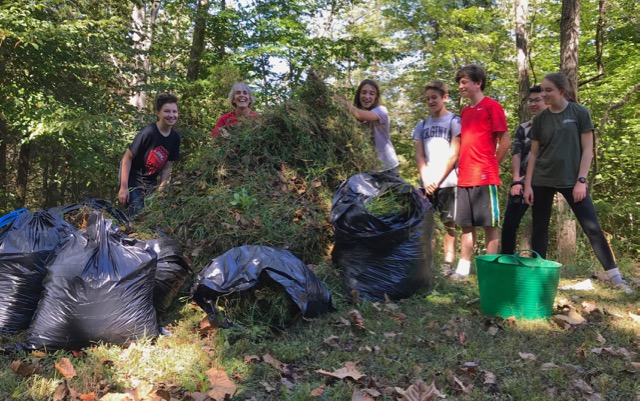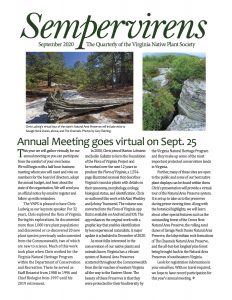Six students from Tandem Friends School’s 8th and 10th grades came to The Quarry Gardens one brilliant October day, and removed an invasive grass they piled into a mountain taller than the tallest of them. The occasion was an all-school community service day when Friends’ students lend time, skills, and muscle to worthy tasks throughout the Charlottesville area.
Here, they took out two large patches of Japanese stilt grass, Microstegium vimineum, where it was running from roadside into woods—it will grow in sun or shade—and threatening native species in an area that had been undisturbed for decades. As a foreign invader, stilt grass gives nothing to local ecosystems. Because insects or animals here are not adapted to use it, its sole function is to smother the native species that other native species depend on.
Kudos and thanks to the students—Sammy Buckley, Meridith Frazee, Elliot Rossman, Joey Spaeder, Josh Warren, and Adam Zhang—and to Christine Hirsh-Putnam, who drove the van and worked along with them. At the end, we celebrated with cookies, as among them were Quarry Gardens’ 1,000th visitor of the year!
Stilt grass may be found in scattered patches throughout the QGs’ 40 acres; its seeds are viable for 3-5 years. We’re using various strategies: hand-pulling around the quarries where desirable plants may be present; grass-specific herbicide or propane-fired torch in other areas.
Some other invaders we’re battling now:
Chinese lespedeza, Lespedeza cuneata—pulling it works if the ground is moist enough to release this perennial’s roots; otherwise, cutting at ground level and immediately dabbing the cut stem with herbicide is (tedious but) effective.
Japanese honeysuckle, Lonicera japonica—offers the advantage of having red stems that are visible through the winter, so it can be pulled whenever the ground is not frozen.
Maiden grass, Miscanthus sinensis (a large grass cultivated on roadsides and gardens that has escaped into woodlands)—the 8-foot-tall ones with massive roots have been all but destroyed; now we’re mostly digging and pulling smaller ones.
Autumn olive, Elaeangnus umbellata—many fewer than two years ago, but cutting and dabbing continues—to good effect.
Among other invasive we took on earlier in the year (to varying effect) were garlic mustard (Alliaria petiolata), carpet grass (Arthraxon hispidus), Japanese privet (Ligustrum japonica), and the native invasive greenbrier, or catbrier, (Smilax rotundiflolia or possibly Smilax bona-nox), climbing vines with nasty thorns that can reach the top of 40-ft trees. Fortunately, we have little poison ivy and no kudzu or wavy leaf grass (knock wood).
If you enjoy such work, or are willing to do it in exchange for becoming a Friend of the Quarry Gardens, please let us know via the Contact button on the website: quarrygardensatschuyler.org. We’ll tell you when we schedule volunteer workdays.

